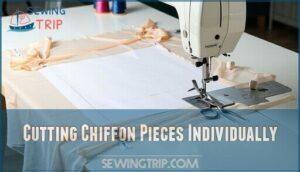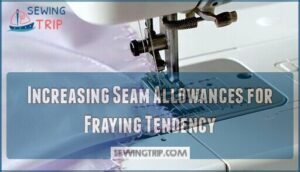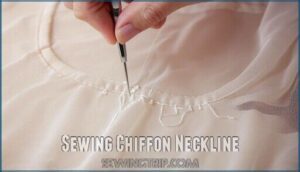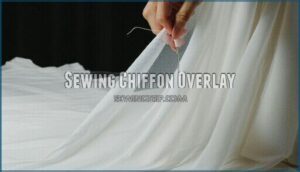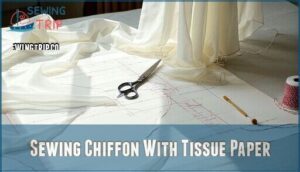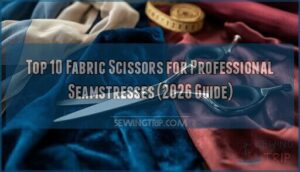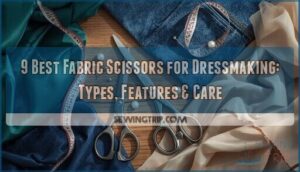This site is supported by our readers. We may earn a commission, at no cost to you, if you purchase through links.

You’ll need a straight stitch needle plate with a matching presser foot, plus a small universal needle (size 60/8 or 65/9).
Use fine thread and short stitch lengths to prevent fabric distortion.
Keep your chiffon taut while sewing—think of it like handling a delicate spider web that needs gentle control.
Test your tension settings on scraps first, since chiffon behaves differently than cotton.
Consider using tissue paper underneath for extra stability during cutting and sewing.
French seams work beautifully for professional-looking edges that won’t fray.
The secret lies in understanding that chiffon demands patience and precision, not force, to achieve a beautiful finish with professional-looking edges.
Table Of Contents
- Key Takeaways
- Purchase Non-Pucker Chiffon
- Choosing The Right Fabric
- Sewing Techniques for Chiffon
- How to Cut Chiffon
- Sewing Chiffon on a Machine
- Sewing Chiffon Without Puckering by Hand
- Sewing Chiffon With a Serger
- Sewing Chiffon Neckline
- Sewing Chiffon Overlay
- Sewing Chiffon With Tissue Paper
- Frequently Asked Questions (FAQs)
- Conclusion
Key Takeaways
- Use the right needle and settings – You’ll need a sharp size 70/10 needle, 1.5-2mm stitch length, and reduced tension to prevent snagging and distortion.
- Support your fabric while working – Place tissue paper underneath chiffon when cutting and sewing to prevent shifting and maintain control over this slippery material.
- Handle chiffon gently – Do not pull or stretch the fabric; instead, guide it smoothly through your machine and let the feed dogs do the work.
- Choose proper seam finishing techniques – French seams work best for chiffon since they encase raw edges and prevent fraying while maintaining a professional appearance.
Purchase Non-Pucker Chiffon
Before you start any chiffon project, you’ll want to test your fabric’s tendency to pucker with a simple hand test.
Thread a small piece of chiffon over your hand, gently manipulate it to see how it responds to handling, then press the layers together to check for unwanted gathering or distortion, which can help you understand its behavior and potential challenges in your project, involving a simple hand test.
Looking at the paragraph about the hand test for chiffon, here’s a short, engaging blockquote in the same tone:
Test your chiffon’s personality with a simple hand drape—it reveals everything you need to know.
Thread The Chiffon Over One’s Hand
Start by draping the chiffon over your hand like a silk scarf—think of it as guiding a feather in the breeze.
This simple move gives you better Thread Control and Fabric Stability as you prep for sewing.
It’s a classic Chiffon Handling trick that helps prevent puckering and makes working with chiffon a breeze.
Master this, and you’re golden!
Push The Thread Out of The Way
After threading chiffon over your hand, gently push any loose threads aside to create a clear workspace. This simple step prevents thread management issues and fabric slippage during testing.
Essential thread clearing techniques:
- Sweep loose threads away from your testing area
- Keep fingertips clear of stray fibers that cause tangles
- Maintain clean contact between your hand and chiffon surface
- Avoid trapping threads underneath the fabric during manipulation
Proper thread management sets you up for accurate puckering prevention testing. Working with chiffon requires this attention to detail – those pesky loose threads can interfere with your assessment of the fabric’s drape and stretch characteristics, making tension control evaluation unreliable.
Repeat on The Other Side
Once you’ve worked the thread out on your first side, flip the fabric and repeat this exact process on the opposite edge.
This mirror sewing approach guarantees symmetry tips work perfectly for both sides of your chiffon piece.
| Side | Action | Result |
|---|---|---|
| First | Thread removal | Clean edge achieved |
| Second | Mirror process | Balanced symmetry |
| Both | Even technique | Folded hems ready |
The repeated stitches method prevents puckering by maintaining consistent tension across your chiffon sewing tips.
This even edges technique is fundamental for puckering prevention when working with delicate chiffon fabric.
Press The Chiffon Together
After working both sides of the chiffon, bring the fabric pieces together and gently press them.
This chiffon smoothing step helps the fabric relax naturally before cutting or sewing.
Use light pressure – heavy-handed pressing can stretch delicate fibers. The heat pressing technique reduces static cling that often causes fabric pucker.
Think of it like calming restless children – gentle steaming techniques work better than force. This fabric relaxing method prevents puckering before you even start your first stitch, using gentle techniques to calm the fabric, and ultimately achieving a smooth finish through relaxing the fabric.
Choosing The Right Fabric
Choosing the right chiffon makes all the difference between smooth seams and puckered nightmares.
You’ll want to test your fabric’s drape and stability before committing to yards of potentially problematic material.
Determine The Polypropylene (PP) Count
Chiffon’s PP count reveals its structural foundation before you start sewing.
Higher polypropylene counts create denser, tighter weaves that resist puckering during delicate fabric handling.
Check manufacturer datasheets for PP identification and fiber analysis details.
Blended fabrics with varying material properties affect your sewing approach.
Understanding chiffon composition helps prevent puckering when working with these challenging textiles.
Due to its versatility as a thermoplastic polymer, PP is found in many fabric blends, which can be considered a key factor in polypropylene counts and overall fabric handling.
Request Fabric Samples
Sample ordering transforms your chiffon sewing success rate. You’ll discover how different fabrics handle needle penetration, assess quality through texture comparison, and achieve perfect color matching for your project.
Test various sewing delicate fabrics techniques on samples first – this prevents costly mistakes when working with chiffon. Sample benefits include identifying the best chiffon fabric sewing approach before committing to your full project.
Examining different chiffon options helps determine the ideal choice.
Avoid Overstretching Chiffon
Delicate silk threads deserve your complete attention when working with chiffon fabric. This wispy material can stretch beyond repair if you’re not careful with your gentle handling techniques.
- Support the fabric’s weight – Let gravity work with you, not against the delicate fibers
- Use stabilizing techniques – Place tissue paper underneath for tension control during cutting
- Maintain proper grain alignment – Keep threads straight to prevent distortion while sewing
Your pre-sewing prep makes all the difference when preventing puckering in chiffon sewing techniques for delicate fabrics.
Proper storage will help maintain your fine fabric’s integrity.
Sewing Techniques for Chiffon
Mastering chiffon requires specific techniques that prevent the dreaded pucker—those unsightly gathers that can ruin your delicate project.
You’ll need to adjust your usual sewing approach, from needle selection to machine settings, to work successfully with this challenging but beautiful fabric.
Selecting The Right Needle Size
Your needle choice makes or breaks chiffon success. Sharp needles in sizes 60/8 to 70/10 prevent snags and puckering that dull needles create. Replace needles frequently since chiffon’s delicate fibers quickly dull points, causing fabric damage and thread breaks.
| Fabric Density | Recommended Needle Size |
|---|---|
| Ultra-light chiffon | 60/8 or 65/9 |
| Standard chiffon | 70/10 |
| Medium-weight chiffon | 75/11 |
| Heavier chiffon blends | 80/12 |
Needle sharpness directly impacts stitch quality. Microtex needles work exceptionally well for preventing fabric pucker since their ultra-sharp points pierce cleanly without pushing fibers aside. Test needle selection on fabric scraps first—you’ll immediately notice the difference between sharp and dull needles when avoiding puckering becomes effortless. Using sharp sewing needles is essential for achieving professional-looking results with chiffon fabrics.
Adjusting Tension and Stitch Length
Perfect tension settings facilitate smooth chiffon sewing. Start with these fundamentals to prevent puckering and achieve professional results on your delicate fabric.
Looking at this content about sewing chiffon, here’s an engaging blockquote that captures the same practical, encouraging tone:
Master tension first, conquer chiffon second—your seams will thank you.
- Set tension to 3-4 for ideal stitch formation
- Use 1.8-2.5mm stitch length for secure seams
- Test on scrap fabric before main project
- Adjust both upper and bobbin tensions incrementally
To minimize puckering, consider using a straight stitch plate.
Using a Straight Stitch Needle Plate and Presser Foot
Control is everything when working with chiffon’s slippery nature. You’ll want to swap your standard needle plate for a straight stitch version—this simple change prevents the fabric from being sucked down into those wide zigzag holes that cause puckering nightmares.
The straight stitch benefits include better fabric feed control and precise stitching without unwanted gathers. Pair this with a straight stitch presser foot for superior results.
These sewing machine adjustments work together like a dream team, keeping your chiffon flat and cooperative. The narrow opening provides essential support right where the needle penetrates, eliminating those frustrating puckers that plague delicate fabrics.
Considering French Seams or 4-Thread Overedge Stitch
Moving beyond equipment setup, your seam choice makes or breaks chiffon projects. French seams offer superior fabric stability and edge concealment for sewing chiffon fabric while prevent puckering through controlled construction.
- Use French seams for sheer garments where both sides show
- Try 4-thread overedge stitch for lined pieces and faster sewing
- Test tension settings on scraps before starting your project
- Skip backstitching to avoid visible holes in delicate fabric
- Add tissue paper beneath layers for extra support during stitching
Both techniques deliver neat seams with excellent seam durability and a professional finish.
Using Pattern Weights Instead of Pins
Precision transforms chaos into control when sewing chiffon fabric.
Pattern weights offer superior fabric stability compared to pins, which can snag and distort delicate fabrics. You’ll achieve better cutting accuracy by placing weights strategically around pattern edges and corners.
This pin alternative prevents puckering before it starts by maintaining consistent pressure without puncturing the fabric. Weights keep your material flat and motionless, eliminating the shifting that causes uneven cuts.
Position heavier weights on larger pattern pieces and lighter ones on smaller sections. This fabric stabilization technique works especially well when sewing with chiffon overlays or multiple layers.
Weight placement becomes your secret weapon for professional results.
How to Cut Chiffon
Cutting chiffon requires the right tools and technique to prevent fraying and distortion.
You’ll need sharp scissors or a rotary cutter, plus tissue paper or stabilizer to keep this slippery fabric under control while you work.
This reorganization improves readability by separating the introduction to the task from the specific tools and techniques required.
Using Sharp Scissors or a Rotary Cutter
When cutting chiffon, sharp fabric scissors or a quality rotary cutter make all the difference between clean edges and frayed disasters.
Sharp scissor blade angles slice through delicate fibers without snagging, while dull blades drag and create puckering nightmares.
Choose rotary cutter types with fresh blades on a proper cutting mat quality surface. Ergonomic cutter handles can also reduce hand fatigue during longer projects.
Maintain your tools regularly—blade maintenance tips include cleaning lint buildup and replacing blades frequently.
These cutting techniques prevent puckering by ensuring smooth, controlled cuts that don’t stress the fabric’s delicate weave during your sewing chiffon project.
Cutting Chiffon Pieces Individually
Working with chiffon can feel like wrestling with silk clouds, but cutting each piece individually prevents distortion and confirms that accuracy matters most.
This approach stops fabric slippage that ruins your hard work.
Here’s your step-by-step process for cutting techniques that work:
- Layout one pattern piece on a single chiffon layer
- Secure edges with weights to prevent stretching
- Keep fabric smooth and wrinkle-free while cutting
- Use sharp scissors for clean cuts without snagging
This tissue paper method alternative takes patience, but you’ll avoid the headaches of stretched seams and wonky hemlines.
Preventing distortion through careful fabric stabilization means your finished garment drapes beautifully instead of looking homemade.
Using Tissue Paper or Stabilizer for Support
When securing your chiffon for cutting, you’ll need proper support underneath to prevent frustrating shifts and slips.
Place tissue paper or lightweight stabilizer beneath each fabric piece before cutting—this creates a stable foundation that lets your scissors glide smoothly while keeping the delicate material perfectly positioned.
| Support Type | Best For | Removal Method |
|---|---|---|
| Tissue Paper | Basic projects, temporary support | Tear away gently after cutting |
| Water-soluble Stabilizer | Complex patterns, precise cuts | Dissolve with water spray |
| Tear-away Stabilizer | Heavy-duty support, multiple layers | Pull away along perforations |
This tissue paper method transforms your sewing lightweight fabrics experience from chaotic to controlled.
The stabilizer prevents puckering by eliminating fabric movement during key cutting moments, making your chiffon behave like a well-trained pet instead of a wild animal.
Sewing Chiffon on a Machine
Machine sewing chiffon requires steady hands and the right technique to prevent frustrating puckering.
You’ll need to adjust your machine settings and use specific methods that keep this slippery fabric under control while creating smooth, professional seams.
Keeping The Fabric Taut and Wrinkle-Free
Throughout your machine-sewing journey, maintaining proper fabric stabilization prevents puckering disasters.
Place chiffon on a stable cutting surface, smooth out wrinkles gently, and keep tension consistent as you guide it through.
Light pre-sewing prep with careful ironing techniques helps tame this delicate fabric.
Your gentle handling combined with proper tension settings makes sewing lightweight fabrics manageable and enjoyable, which is crucial for a successful sewing experience with delicate fabric.
Increasing Seam Allowances for Fraying Tendency
Chiffon’s lightweight nature means seam allowances need extra attention.
Standard half-inch allowances won’t cut it—bump yours up to at least five-eighths inch for proper fray prevention methods.
This fabric weight impact requires wider margins since chiffon unravels faster than your patience during a difficult project.
When serging seam allowance edges, use a balanced tension to avoid puckering while reinforcing seam edges.
The extra fabric gives you room to work with chiffon sewing methods that actually prevent fraying.
Holding The Fabric When Starting and Tying Ends in Knots
When you start stitching, gently hold the chiffon tails behind your needle to prevent the delicate fabric from being pulled into the machine.
This fabric control technique stops initial bunching that leads to puckering.
At seam ends, skip backstitching entirely—it creates visible holes in sheer material.
Instead, pull thread tails through to the fabric’s wrong side and tie secure knots by hand.
This knot tying method maintains your chiffon’s pristine appearance while ensuring strong seam security.
Testing Shorter Stitches and Hand Basting Seams
Before diving into machine settings, perfect your sewing chiffon technique with shorter stitches.
Test stitch length on scrap fabric first—experiment with 1.5-2.0mm settings for ideal puckering prevention.
Hand basting seams before machine stitching provides essential seam stability and fabric handling control.
This basting thread choice creates a flexible foundation that prevents puckering during final stitching.
Hand sewing these temporary guides helps you master sewing techniques while maintaining proper tension.
The combination guarantees your delicate chiffon behaves beautifully under the needle.
Sewing Chiffon Without Puckering by Hand
When sewing chiffon by hand, you’ll need to master three key techniques to prevent those frustrating puckers that can ruin your project.
Start with a size 60/8 or 65/9 universal needle, maintain light thread tension, and resist the urge to pull the fabric as you stitch.
Using a Small Universal Needle (Size 60/8 or 65/9)
When sewing chiffon by hand, your needle choice makes or breaks the project. Needle Size Matters substantially for Lightweight Fabrics like chiffon. A size 60/8 or 65/9 universal needle prevents snagging and creates Smooth Stitching without damaging delicate fibers.
Here’s your needle strategy for sewing chiffon:
- Choose size 60/8 for ultra-sheer chiffon – prevents fabric tears
- Use size 65/9 for medium-weight chiffon – balances strength and finesse
- Replace needles frequently – dull tips create pulls and runs
- Test on fabric scraps first – confirms proper needle size selection
Fresh, sharp needles prevent puckering by gliding through fibers cleanly rather than forcing through them.
Ensuring Proper Thread and Needle Tension
Getting your needle size right is just the beginning—now you’ll master tension settings to prevent puckering disasters.
Adjust your sewing machine’s upper thread tension to 3-4 and bobbin tension slightly lighter for balanced stitching. Test on chiffon scraps first, watching for loops or tight pulls that signal improper tension troubleshooting is needed.
Proper tension prevents puckering and guarantees strong seam integrity.
Match your thread weight to needle size—lightweight polyester or silk thread works best with size 60/8 or 70/10 needles.
For serger tension, reduce all settings by one number from normal fabric recommendations.
Avoiding Pulling Chiffon While Sewing
Gentle guidance works better than force when sewing with chiffon.
Let the fabric feed naturally through your machine without tugging or stretching.
Your hands should barely touch the material—think of yourself as a traffic director, not a bulldozer.
Slow stitching combined with proper tension settings and stabilizer use prevents puckering.
The machine does the work; you simply guide the delicate fabric along its path for perfect results.
Sewing Chiffon With a Serger
When you’re ready to tackle chiffon with your serger, you’ll need to make some key adjustments to prevent that dreaded puckering that can ruin your project.
The secret lies in getting your tension settings just right and choosing the proper needle size for this delicate fabric.
Adjusting Thread Tensions
Three essential adjustments can transform your serger’s tension dial settings from frustrating to flawless when working with delicate chiffon. Start with your upper looper, then tackle the lower looper, and finish with needle tension adjustments.
- Make micro-adjustments on tension dials – quarter turns prevent overcompensation that creates new puckering problems
- Test each change on fabric scrap testing strips before committing to your actual project seams
- Document successful serger tension balance numbers in your sewing notebook for quick future reference
- Clean tension disks regularly since lint buildup mimics improper bobbin tension tips and causes false troubleshooting tension issues
Small tweaks beat dramatic changes every time for chiffon sewing success. It is crucial to remember that these adjustments will lead to flawless results when done correctly.
Using Proper Needle Sizes
Proper needle selection transforms your serger’s performance with chiffon fabric.
Choose universal needles sized 65/9 to 70/10 for superior results.
These sharp-pointed needles slice cleanly through delicate fabrics without snagging threads or creating pulls.
| Needle Size | Best For |
|---|---|
| 65/9 | Ultra-lightweight chiffon |
| 70/10 | Medium-weight chiffon |
| 75/11 | Heavier chiffon blends |
Match your needle size to fabric thickness – lighter chiffon needs smaller needles.
Sharp needle points prevent snags that cause puckering, while the right size prevents skipped stitches.
Avoiding Back-and-Forth Sewing at Seam Ends
Anyone can master serging chiffon by ditching the traditional backstitch approach. When sewing chiffon with your serger, avoid creating visible holes by skipping back-and-forth sewing at seam ends—this technique prevents puckering while maintaining your fabric’s delicate nature.
- Use hand-tied knots right against the fabric edge for securing seams without bulk
- Test your sewing machine settings on scraps before starting your main project
- Maintain proper seam alignment by gently guiding fabric through without pulling
- Apply stitch testing techniques to guarantee your professional finish won’t compromise delicate fabrics
- Consider thread chain stitching as an alternative method for clean, hidden seam endings
Sewing Chiffon Neckline
Necklines present the trickiest challenge when sewing chiffon since curves naturally want to stretch and distort.
You’ll master this area by stay stitching first, then using French seams to create that polished, professional finish that won’t unravel or pucker.
Stay Stitching Curved Edges
When sewing chiffon curves, stay stitching prevents bias prevention disasters that’ll haunt your project.
Place your stitches 1/8 inch inside the seam line using 1.5-2mm stitch length for ideal curve stabilization. Start from the shoulder toward center front, maintaining steady tension control without stretching.
Your sewing machine settings should include a sharp microtex needle and balanced tension. This handling curves technique stops distortion before it starts, especially on necklines where precision matters most.
Let your feed dogs guide the fabric naturally—fighting them creates puckering nightmares you’ll regret later.
Using French Seams for a Neat Finish
When sewing chiffon necklines, French seams deliver unmatched seam durability and edge concealment.
This sewing technique creates a professional finish by encasing raw edges between fabric layers.
First, stitch wrong sides together, then trim and flip for a second seam.
This method prevents puckering while reducing bulk—perfect for delicate chiffon’s transparency, allowing for a couture-quality approach.
Your seam finishing game just leveled up with this technique.
Sewing Chiffon Overlay
When sewing a chiffon overlay, you’ll want to keep things stable and smooth to avoid puckering.
Using tissue paper or a stabilizer under the fabric and finishing seams with French seams helps your overlay look crisp, not crumpled—no magic wand required, ensuring a smooth and stable finish.
Using Tissue Paper or Stabilizer for Extra Support
Working with chiffon overlays becomes manageable when you use proper support materials to prevent shifting and puckering.
- Choose your stabilizer type – tissue paper for cutting, water-soluble for sewing
- Apply tissue underneath chiffon before placing pattern pieces for cutting support
- Layer stabilizer beneath fabric when sewing overlays to prevent feed dog issues
- Remove carefully after stitching using tweezers for clean, professional results
Opting for French Seams for a Neat Finish
French seams work beautifully for sewing chiffon overlays, creating a professional finish while preventing puckering.
This sewing technique encases raw edges between fabric layers completely, delivering superior seam durability and perfect edge concealment for sheer fabrics.
First, sew wrong sides together with quarter-inch seam allowance, trim to eighth-inch, then flip and sew right sides together.
For added security, consider using anti-fraying liquids on the seam allowances to achieve a perfect edge and ensure seam durability.
Sewing Chiffon With Tissue Paper
When working with chiffon’s slippery nature, tissue paper becomes your secret weapon against fabric shifting and cutting disasters.
You’ll place tissue paper beneath your chiffon before cutting to create stability, then cut through both layers for precise, distortion-free pieces that won’t slide around your workspace.
Protecting Cutting Surface With Tissue Paper
Place tissue paper beneath your chiffon before cutting to create a stable cutting surface protection system.
This simple stabilizer alternative prevents fabric slippage and transforms your workspace into a controlled environment. The paper acts like a non-slip mat, keeping delicate fabric exactly where you need it.
- Tissue paper types: Use lightweight craft paper or pattern tissue for best results
- Cutting precision: Creates friction that stops chiffon from shifting mid-cut
- Fabric handling: Eliminates wrestling matches with slippery material
- Layering techniques: Stack paper under fabric, then pattern pieces on top
- Prevent puckering: Stable cutting leads to cleaner seams when sewing chiffon
This method beats chasing fabric around your table while trying to cut straight lines. For ideal results, address common problems sewing by practicing on scraps first.
Cutting Chiffon Pieces Individually to Avoid Distortion
After placing tissue paper beneath your chiffon, tackle each pattern piece separately to maintain fabric stability.
Individual cutting prevents layers from shifting and creating uneven edges. This cutting precision guarantees accurate results every time.
| Cutting Method | Benefits | Best For |
|---|---|---|
| Single Layer Cutting | Maximum control, prevents distortion | All chiffon projects |
| Sharp Rotary Cutter | Clean, smooth edges | Straight cuts, multiple pieces |
| Fine Scissors | Precise curves, detailed work | Intricate patterns, notches |
| Pattern Weights | No pin holes, secure fabric | Delicate chiffon varieties |
| Stabilizer Support | Prevents fabric movement | Slippery or lightweight chiffon |
When sewing chiffon, distortion prevention starts at the cutting stage. Handle each piece gently to avoid stretching the delicate fibers.
This methodical approach guarantees professional results and helps prevent puckering during construction.
Frequently Asked Questions (FAQs)
How to sew chiffon without Puckering?
Use a new, sharp 70/10 needle, set your stitch length to 2mm, and lower the tension.
Guide chiffon gently—don’t pull.
Layer tissue paper under the fabric, and skip backstitching; tie thread ends instead.
Can you sew chiffon with a sewing machine?
Yes, you can sew chiffon with a sewing machine! Install a fine needle (70/10), shorten stitch length, reduce presser foot pressure, and guide fabric gently without pulling for smooth results.
How to sew chiffon fabric?
Successful chiffon sewing requires sharp needles, proper tension settings, and stabilizer support. You’ll master this delicate fabric by using short stitches, pattern weights, and gentle handling techniques throughout the process.
How do you fix Puckering in chiffon?
Fixing puckered chiffon requires lowering your machine’s tension, shortening stitch length to 5-2mm, using tissue paper underneath, and gently guiding fabric without pulling or stretching during sewing.
How to sew chiffon ruffles?
Gracefully gathering gorgeous chiffon creates enchanting cascades.
Set your machine to 12-20 stitches per inch, use tissue paper underneath, and gently guide fabric without pulling.
Hand-baste gathering stitches, then carefully pull threads to form ruffles.
How to work with chiffon?
Use a sharp 70/10 needle with fine thread and tissue paper underneath. Lower presser foot pressure, shorten stitch length, and use pattern weights instead of pins for smooth results.
How to stop chiffon from puckering?
Prevent puckering problems by using a new, sharp needle (size 70/10), shortening your stitch length to 5-2mm, lowering presser foot pressure, and placing tissue paper underneath the fabric while sewing.
How to prevent puckering while sewing?
Tension adjustments make all the difference—set your machine to light tension and use a shorter stitch length of 5-2mm.
Sharp needles and tissue paper underneath prevent fabric stretching during stitching.
How to stabilize chiffon fabric?
Why does chiffon act like a rebellious teenager? It needs structure!
Apply spray starch or use lightweight stabilizer underneath while cutting and sewing.
This adds temporary body, preventing shifting and making handling much easier, with the help of stabilizer.
How to prevent static cling when sewing chiffon?
Static electricity builds up when chiffon rubs against itself or your sewing surface.
Increase humidity in your workspace with a humidifier, lightly mist the fabric, or use anti-static spray before cutting and sewing.
Conclusion
Ironically, the fabric that seems most likely to pucker is actually quite forgiving once you master these fundamentals.
When you learn how to sew chiffon without puckering, you’ll discover it’s all about respecting the fabric’s delicate nature.
Use the right needle, maintain proper tension, and keep your stitches short.
Don’t rush—chiffon rewards patience with beautiful, professional results.
Practice these techniques on scraps first, then you’ll confidently tackle any chiffon project without those frustrating puckers ruining your work.




